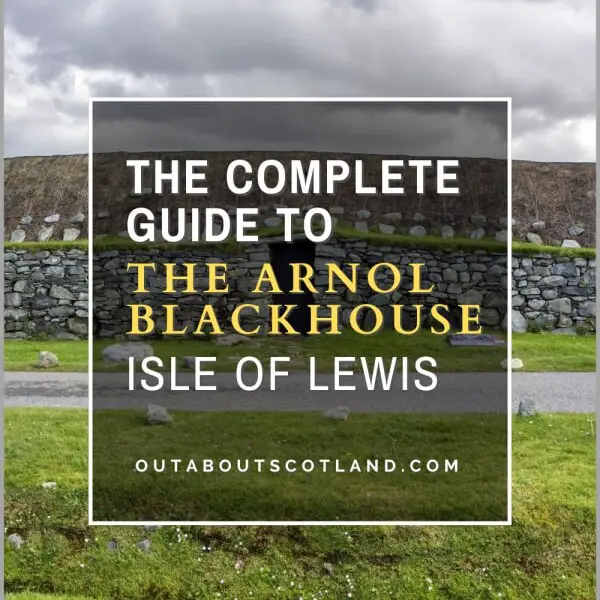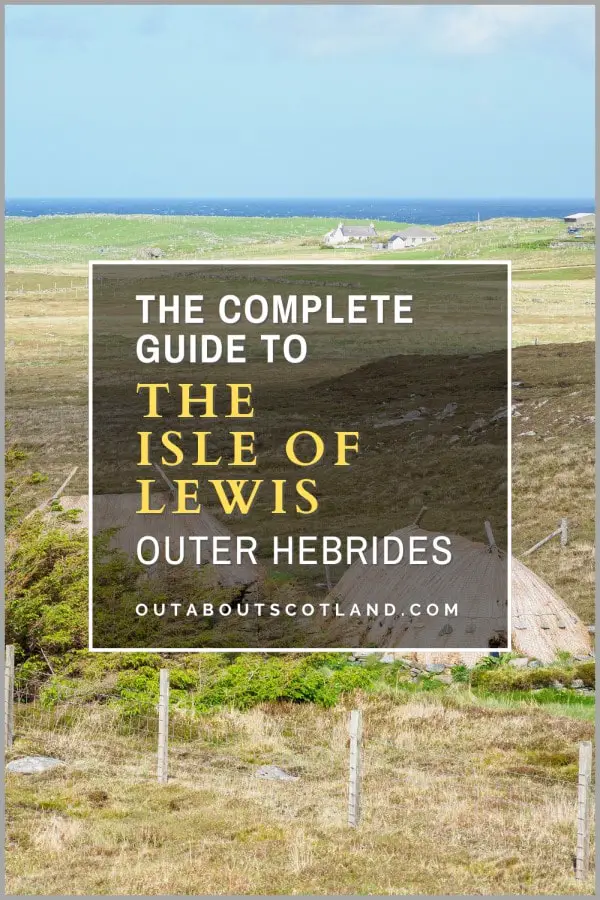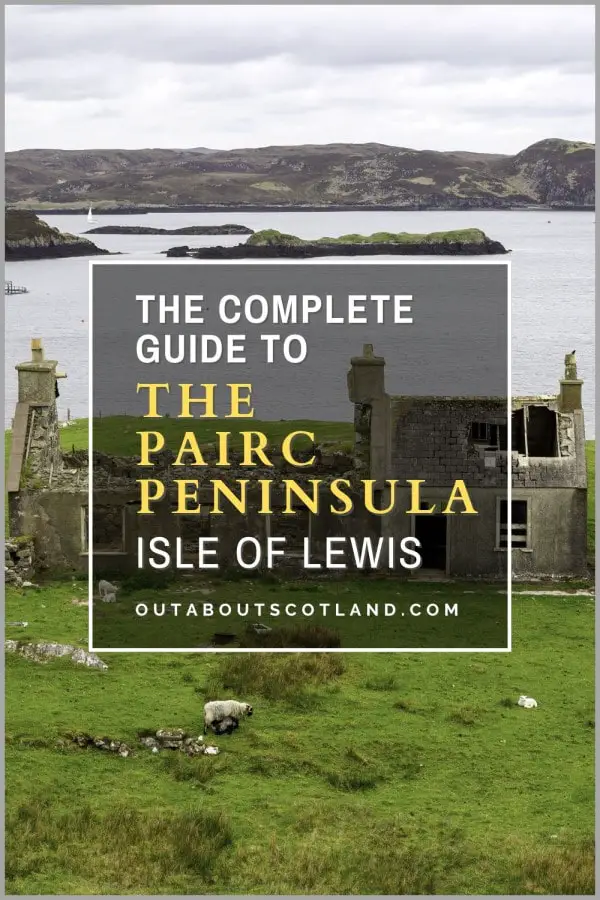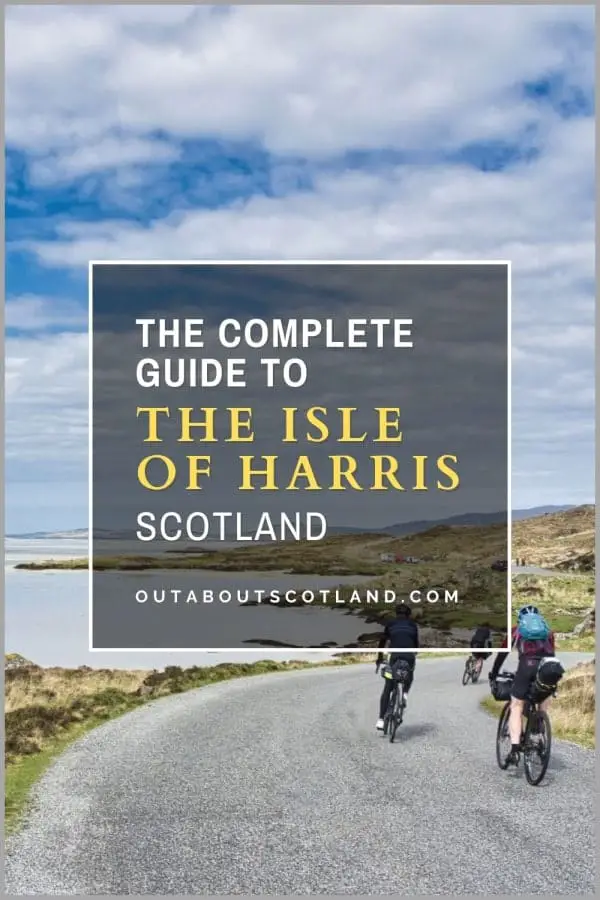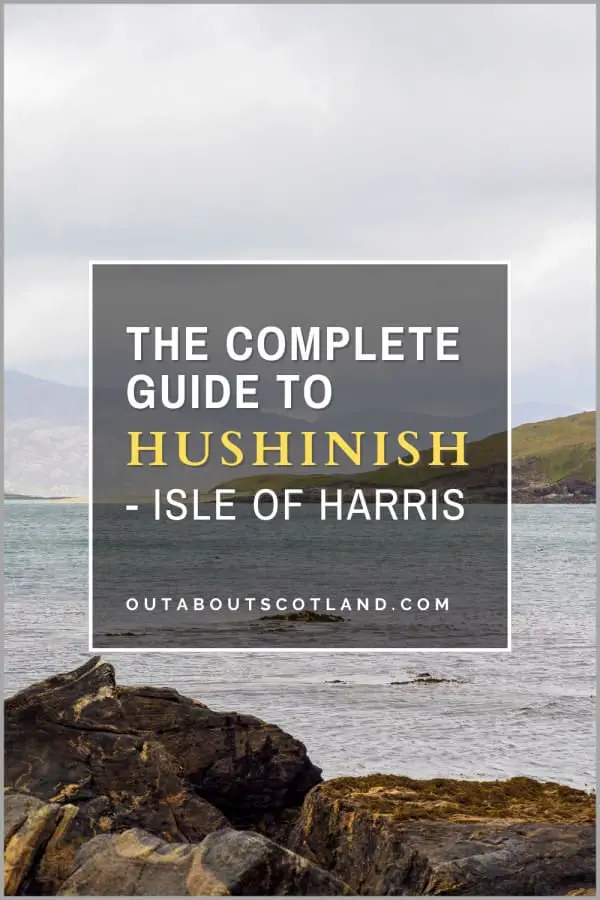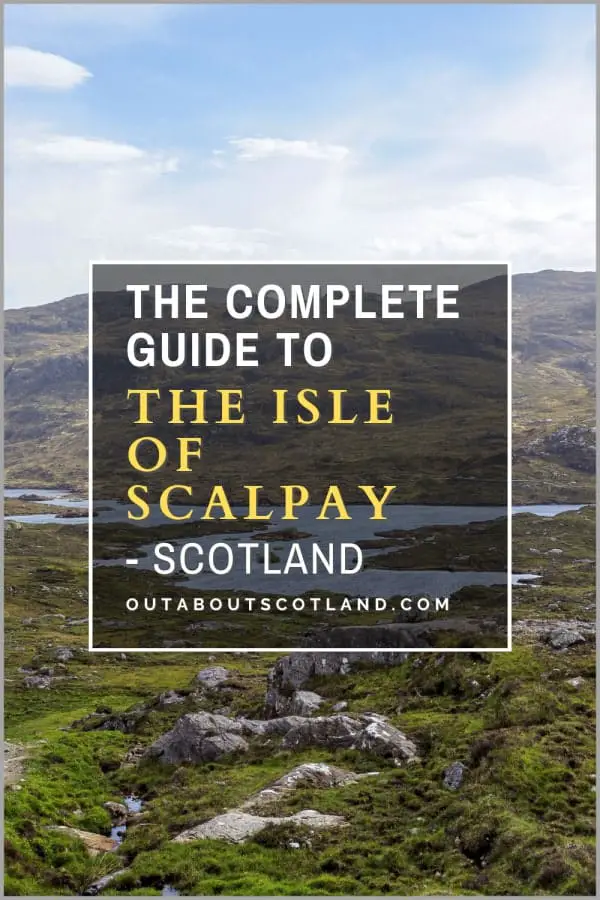The Arnol Blackhouse on the Isle of Lewis is a fine example of one of the traditional thatched stone-walled houses that served as home to both people and animals on Scotland’s west coast islands for hundreds of years. The renovated building at Arnol (number 42) is in a picture-perfect location with wide-open fields all around it and actual piles of cut peat and harvested crops.
Visitors can explore this fascinating former crofter’s house on Harris and Lewis courtesy of Historic Environment Scotland, which allows paid access to the building on most days.
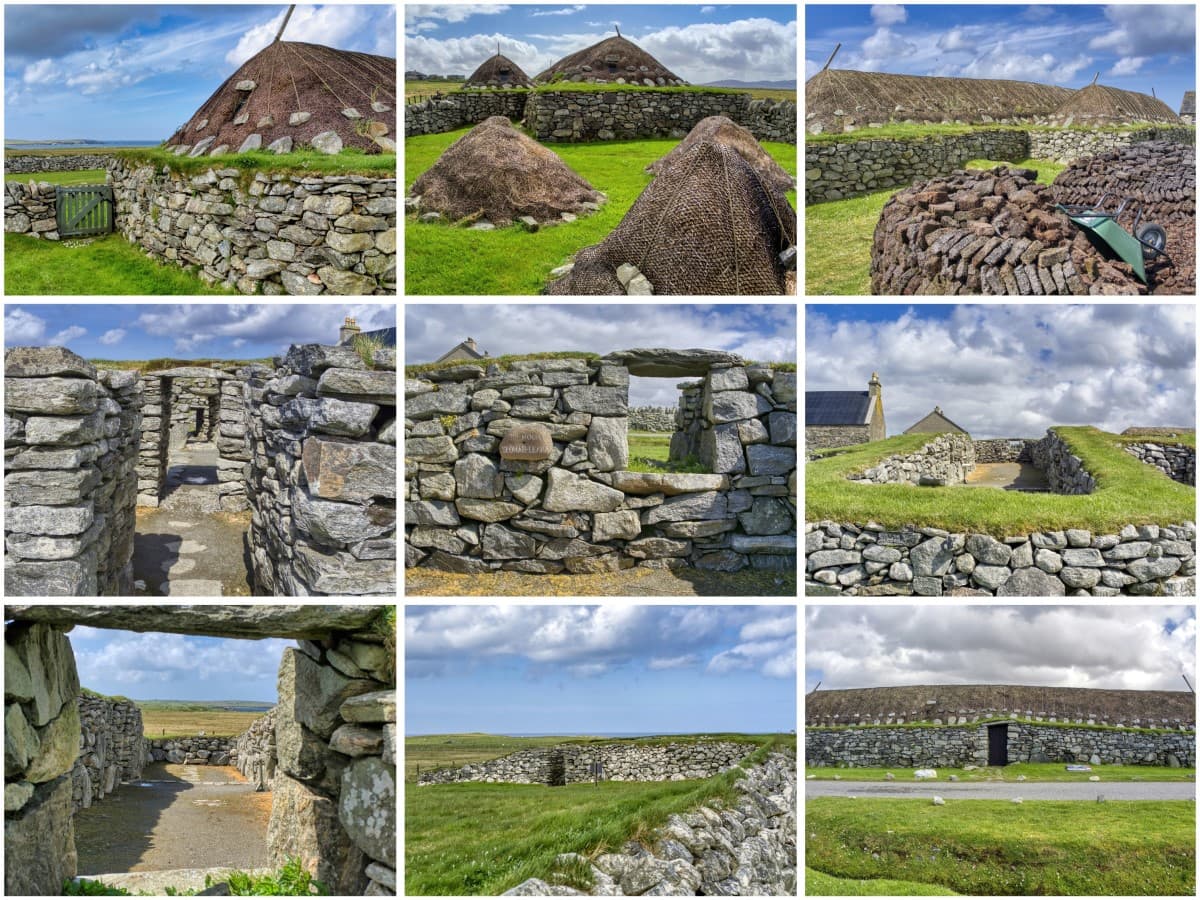
| Address: | 42 Arnol, Bragar, Isle of Lewis, HS2 9DB |
| Opening Hours: | 1 Apr to 30 Sept: Daily except Wed & Sun, 10am to 4pm Last entry 3.30pm. 1 Oct to 31 Mar: Daily except Wed and Sun, 9.30am to 4pm Last entry 3.30pm. |
| Admission Price: | Adult (16-64yrs): £7.00 Concession (65yrs+ and unemployed): £5.50 Child (5-15yrs): £4.00 Family (1 adult, 2 children): £14.00 Family (2 adults, 2 children): £20.00 Family (2 adults, 3 children): £24.00 |
| Parking: | Free on-site parking |
| Contact: | 01851 710 395 |
| Facilities: | Shop, drinks machine, toilets, water refill |
| Photos: | Virtual Tour YouTube Video |
Overview
One of the defining features of the Outer Hebrides is the remains of traditional blackhouses that dot the landscape on the majority of the islands. Most of these dwellings are now little more than ramshackle collections of stones, but at Arnol, on the northwest corner of Lewis, there is a perfectly preserved example that has been opened up to the public.
If you’re not familiar with blackhouses, they’re basically long, low buildings that served a dual purpose as a family home and a stable for animals. The walls are comprised of large, roughly cut stones stacked on top of each other in a layer of two walls, with the gap between them filled with a combination of earth and peat.
To look at them, they appear ancient (the original design does stretch back over 5,000 years, after all), but many blackhouses were, in fact, built as late as the 1900s. The design was so good that some residents lived in them right up until the 1980s, but without electricity or running water, they were all eventually abandoned.
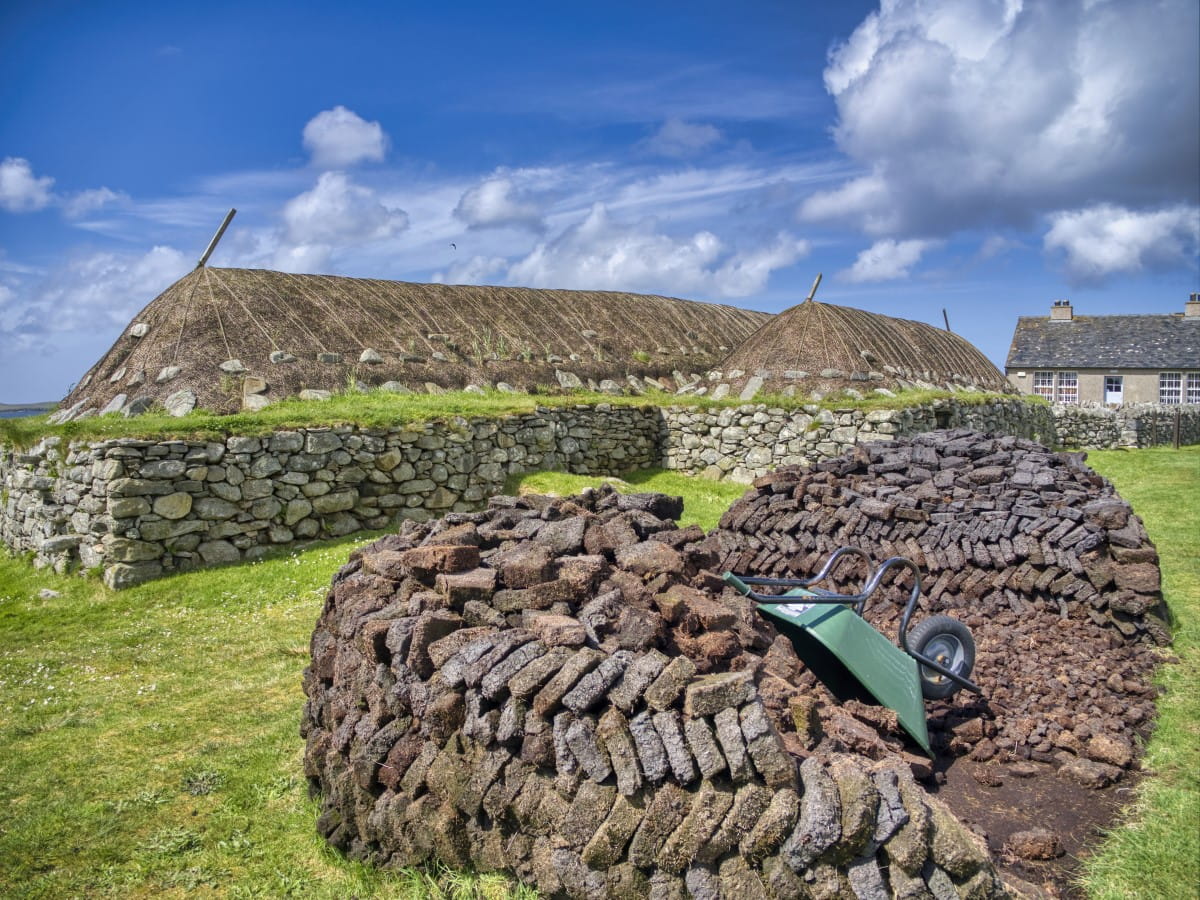
At Arnol, visitors can experience what life would have been like for the hardy islanders who spent their lives in these dwellings thanks to Historic Environment Scotland which looks after No. 42, a fully restored building that was built in 1880 by a family of Hebridean crafters.
Opposite the blackhouse is a byre where animals were later housed following a change in Scotland’s building regulations, as well as a restored example of a ‘white house’ which eventually came to replace the old blackhouses.
HES has installed a visitor centre in one of the adjoining buildings, which features a small shop and an exhibition area. There is also parking and partial disabled access to the site. As to be expected, there is a small admission fee to enter the blackhouse, but visitors are free to walk around the exterior at their leisure.
Finally, although a visit to Arnol Blackhouse is easily completed in under an hour, visitors might like to spend a little while longer in the area thanks to the surrounding nature reserve, which is a fantastic place for birdwatching due to the vast swathes of machair and a number of scenic lochs.
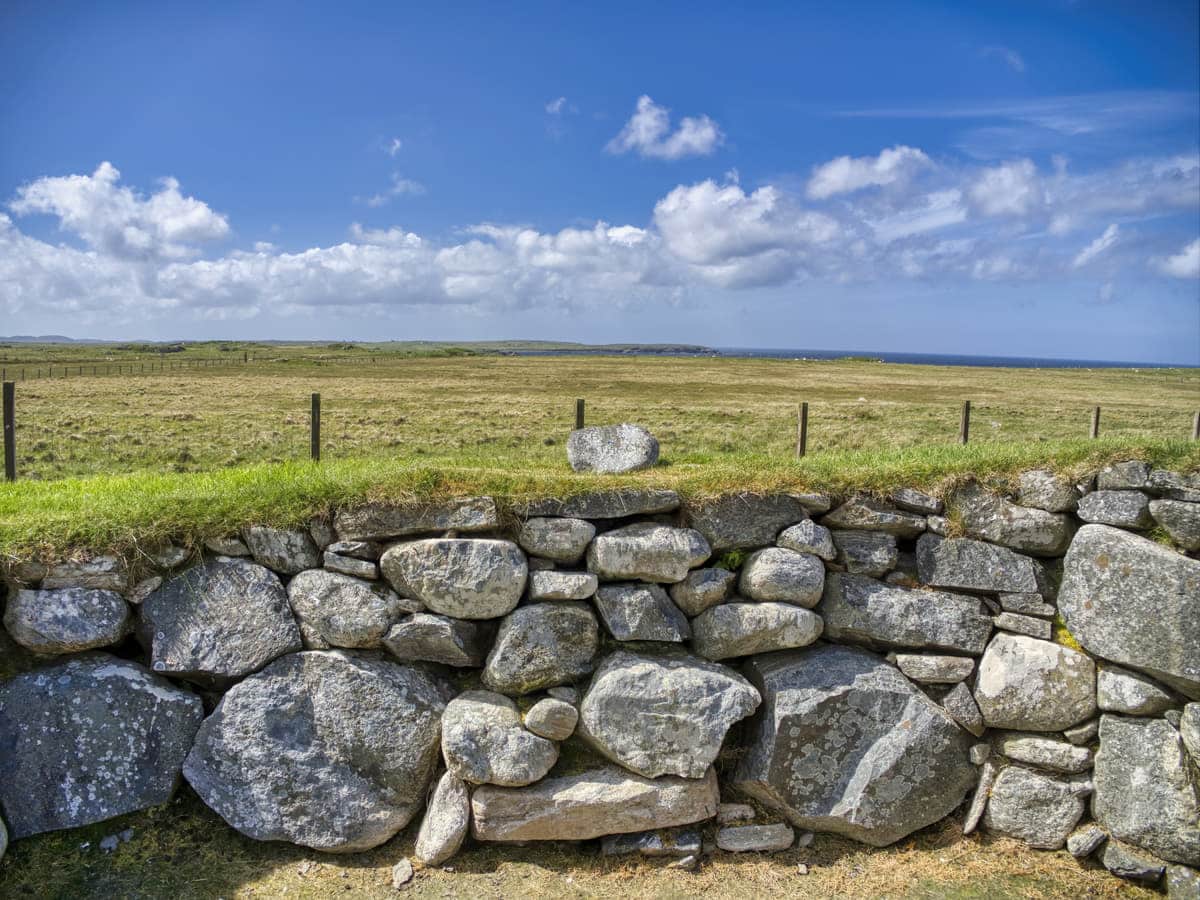
The Highlights
1: This is an interesting glimpse into traditional island life that existed right up until the 1980s. Arnol Blackhouse is one of the best-preserved examples of these dwellings and is a must-visit attraction in addition to Gearrannan Village.
2: Historic Environment Scotland also manages one of the original whitehouses that brought an end to blackhouses. This example was built in the 1920s. In addition, the site has one of the few remaining traditional byres – a walled enclosure for cattle.
3: The area surrounding Arnol is a great place for wildlife watching thanks to the swathes of machair (one of Europe’s rarest habitats, consisting of wild grasses and flowers) which is a haven for nesting birds.
Visiting Tips
1: Please note that Arnol Blackhouse is closed to the public on Wednesdays and Sundays. However, access to the exterior is possible every day. There is a fee to enter the blackhouse, but entry is free for HES members.
2: For an alternative look at Scottish blackhouses visit Gearannan which lies 10 miles to the south. The village buildings were built in the same style as Arnol but the interior of the museum building is slightly more modern.
3: If history doesn’t float your boat you might enjoy wandering around Arnol Beach which is part of a nature reserve. Small boulders and stones make up the beach, which has the lovely Loch Arnol as its backdrop.
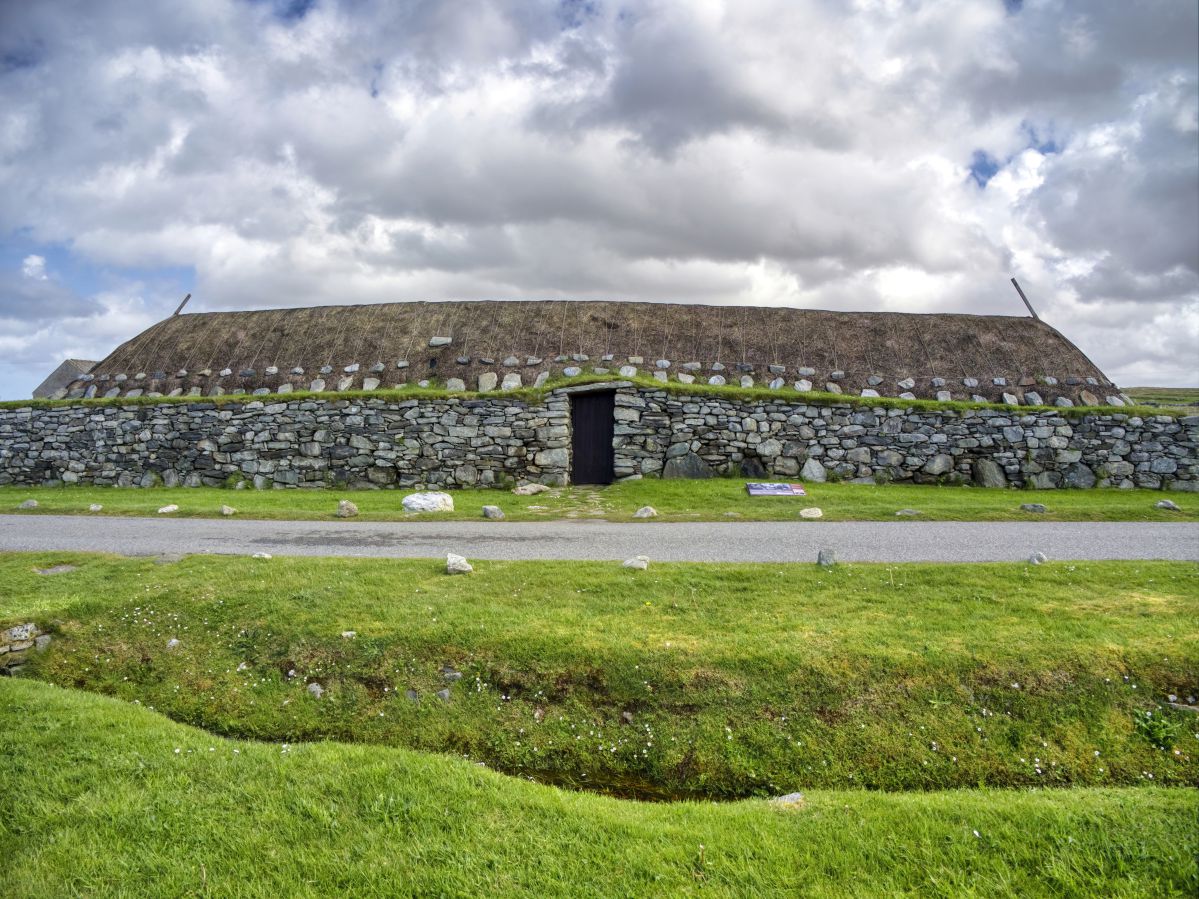
Tourist Information
Although the northwest of Lewis is often regarded as having a rather uninspiring landscape due to mile after mile of boggy marshland, it’s nonetheless dripping with history. Huge standing stones can be seen at Clach An Truishal and Steinacleit; the incredible Calanais standing stone circle lies to the south; and some of the best-preserved blackhouses can be found at Gearannan and Arnol.
While Gearranan Blackhouse Village is the more interesting site in my opinion, it’s worth visiting Arnol as it’s the better preserved of the two and has an arguably more authentic feel to it. Getting there is simple enough from the A858, and it’s close enough to Gearrannan that both attractions can be visited in a single afternoon.
Upon entering the site you’ll find a small car park and a visitor centre with the blackhouse to one side and the remains of long-abandoned blackhouses nearby. Be aware that this is one of Historic Environment Scotland’s smaller sites, so I’d plan no more than an hour there, but you’ll have plenty of photo opportunities, and the atmosphere of the place is worth the admission price alone.
The visitor centre features an interesting exhibition about the Isle of Lewis and island life but the main attraction is, of course, the restored blackhouse next door. Entry is through low doors that open up into an interior space that’s deceptively large, but then it would have had to house a collection of farm animals back in the day, alongside the family and all their belongings.
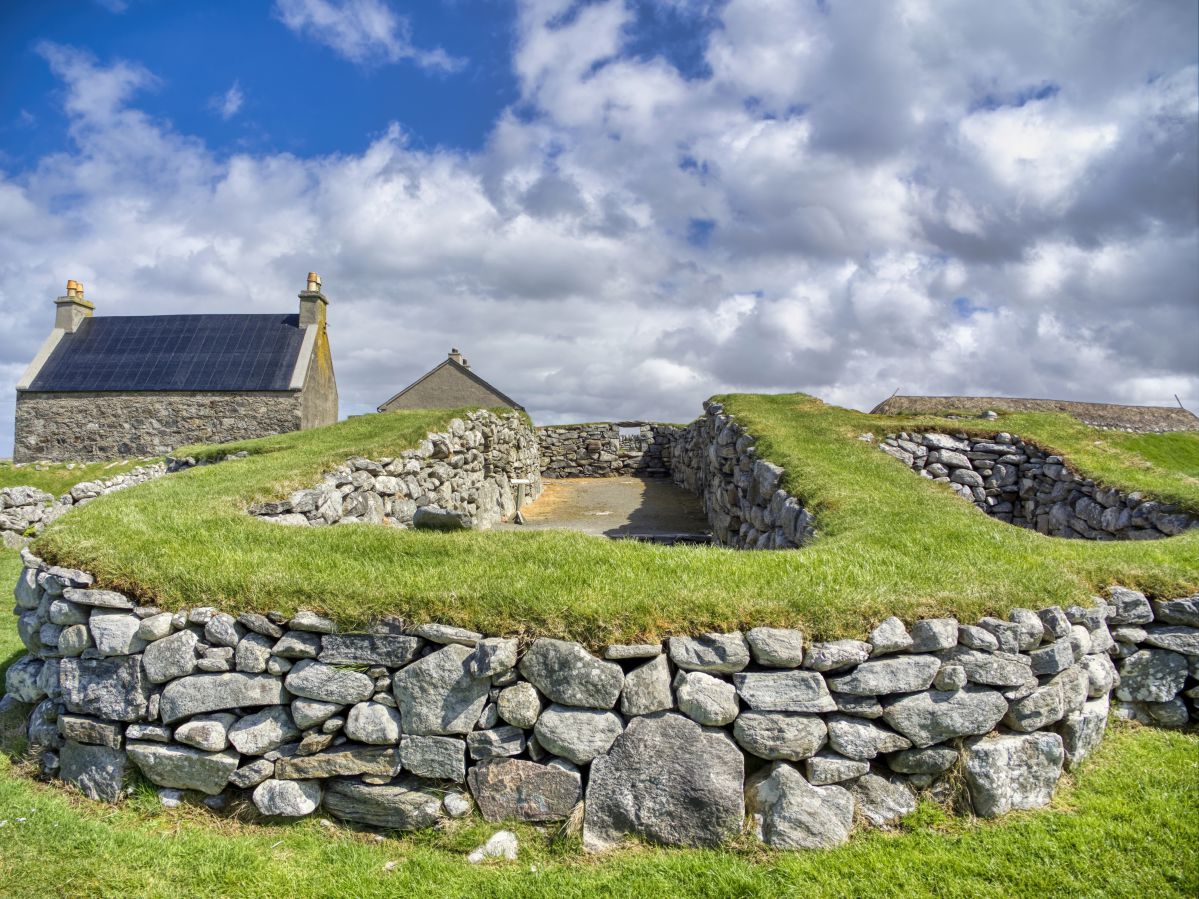
One surprising feature is the huge mound of fresh-cut peat that sits at the back of the building. This feeds an open hearth that would have been the main source of heat for the residents, even though there are no chimneys or windows to clear the air.
Instead, the smoke is allowed to filter up through the thatched roof which is thick with black soot (one of the reasons for the ‘blackhouse’ name), leaving in its wake a thick musty smell of burnt peat which is actually very pleasant.
There are a few original items of furniture inside the blackhouse to give visitors a good idea of what living there would have been like, while outside there are ruined walls of other homes as well as a traditional byre where animals were later kept.
One final point I have to make about visiting Arnol is that there are some superb views of the coastline to be enjoyed from the ruined former dwellings. In addition, there is a lot of wildlife in the surrounding nature reserve, so you might like to consider purchasing a pair of binoculars (link to my birdwatching binocular reviews) before your visit.
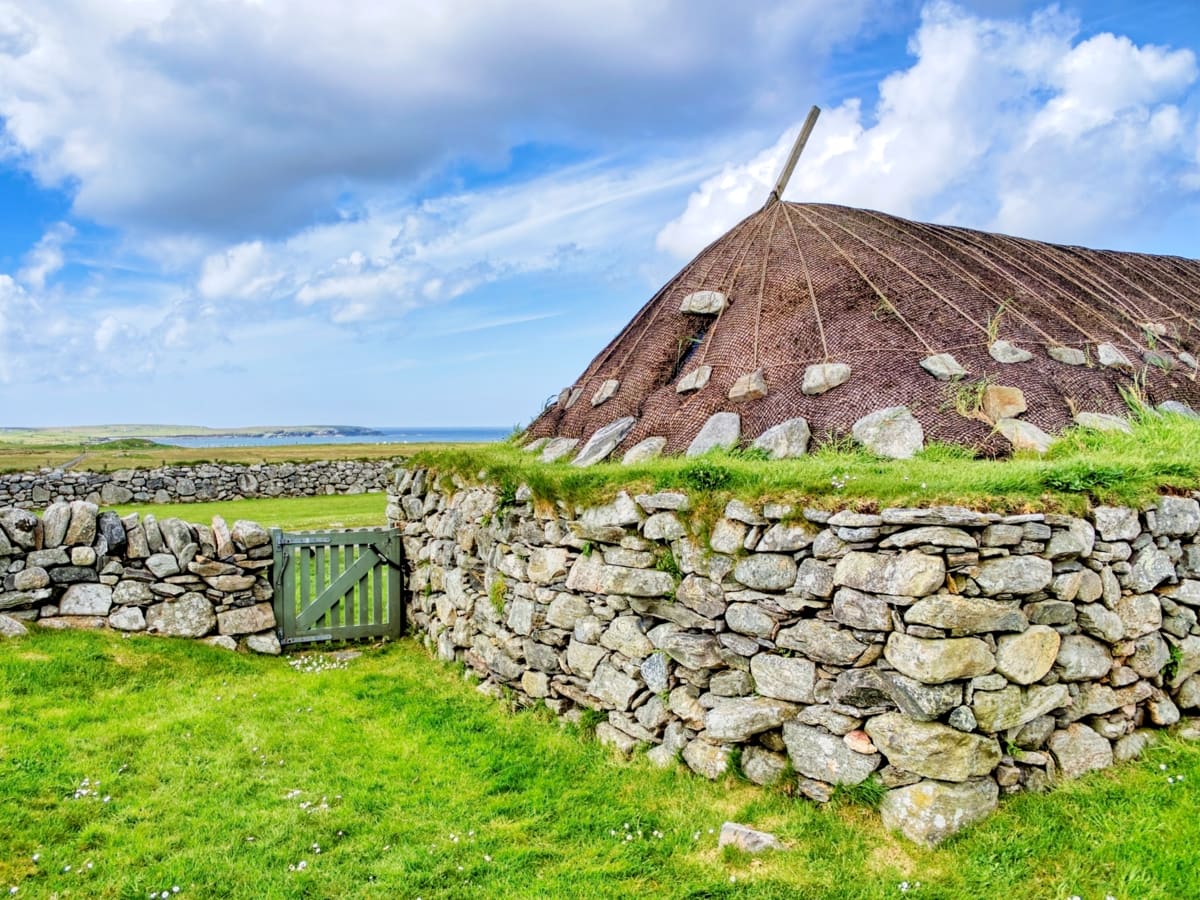
Things to Do
Explore the Blackhouse: The Arnol Blackhouse is a preserved traditional Scottish house with a design heritage that’s at least 2,000 years old. You can walk through the rooms and take a glimpse into 19th-century island life before heading across the road to admire the coastal grasslands.
Visit the nearby White House: Just opposite the Blackhouse, you can discover the 20th-century ‘White House’. It provides a stark contrast to the Blackhouse and offers insights into the evolution of island living.
Complete the Explorer Quiz: Younger visitors might like to print out the online quiz (see the HES website for details) and then explore the blackhouse to find the answers to each question.
Wildlife Watching: Arnol Blackhouse is surrounded by a stunning landscape. You can spot a variety of local birds in the area and if you venture down to Arnol Beach there’s a good chance you’ll spot seals lounging on the rocks.
Photography: The combination of the Blackhouse’s rustic charm, the surrounding landscapes, and the ever-changing Scottish weather make this a great spot for photography. Whether you’re a professional or just enjoy taking pictures with your phone, this is an excellent opportunity to snap some truly remarkable shots.
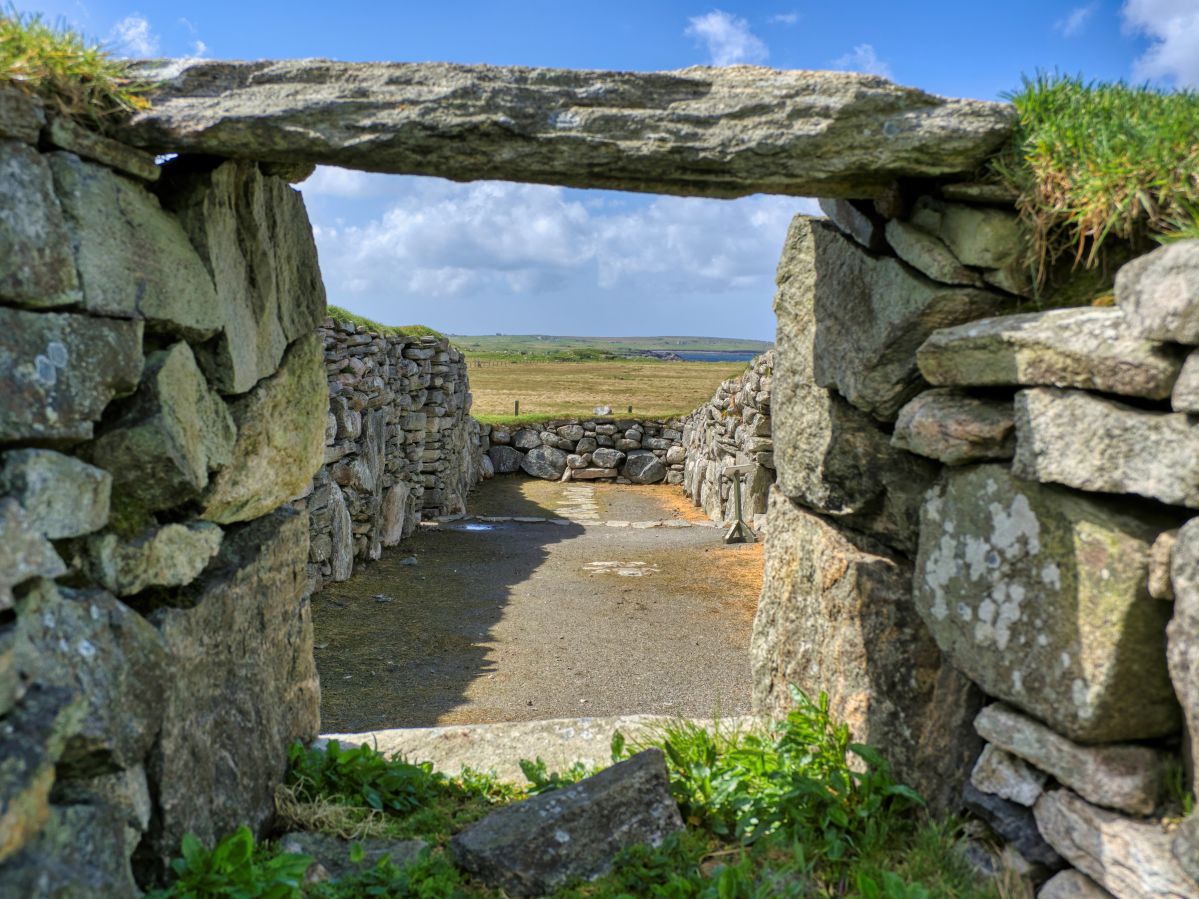
Things to Do Nearby
Gearrannan Blackhouse Village. Address: Garenin, Isle of Lewis, HS2 9AL. Distance: 10.3 miles.
A complete village of restored Scottish blackhouses in a spectacular coastal setting on the west coast of Lewis. Although most of the blackhouses have been converted into holiday accommodations, some have been fully restored and turned into a museum that shows how people lived in blackhouses in the late 1800s. Facilities include a car park, café, and gift shop.
Norse mill and kiln. Address: Isle of Lewis, HS2 9BJ. Distance: 5.5 miles.
A fine example of two restored Scandinavian buildings situated next to Loch Raoinebhat. There were more than 200 such mills and kilns in the past, but few remain today. The kiln was surprisingly still in use until the 1930s. The mill and kiln are free to visit and are accessible via a small car park off the A858.
Shawbost Beach. Address: North Shawbost, Isle of Lewis HS2 9BQ. Distance: 5 miles.
A clean and attractive beach on the west coast of the Isle of Lewis. The beach is well known for its spectacularly clean water as well as the flocks of wading birds that forage on the shoreline throughout the year.
Clach An Truishal and Steinacleit standing stones. Address: Isle of Lewis HS2 0RL/HS2 ORG. Distance: 7.3/8.3 miles.
Ancient standing stones that are believed to have ties to the more famous Calanais stone circle located to the south. The Clach An Truishal standing stone is the largest in Europe.
Dalmore Beach. Address: Carloway, Isle of Lewis, HS2 9AD. Distance: 9.3 miles. With cliffs enclosing it and a number of sea stacks dotting the coastline, this golden-sand beach is located in a shallow bay. Dalmore Beach is frequently listed as the top beach on Lewis.
Frequently Asked Questions
When did people stop living in blackhouses?
The design of Scottish blackhouses originated several thousand years ago, consisting of a twin-walled building that had a layer of insulating peat in the gap between the stone walls.
This design proved resistant to Scotland’s west coast weather and was unrivalled until a new design (named ‘white houses’) arrived which separated the living quarters between animals and people.
As modern building techniques were brought onto the islands the traditional blackhouses fell out of favour and most of them were abandoned by the early 1900s.
The last permanent residents of Scottish blackhouses finally moved out for good in the 1980s.
Today, many of the old buildings have been renovated and are now used as holiday accommodation.
Why is it called a blackhouse?
The origin of the name ‘blackhouse’ can be traced to three potential reasons.
First, these dwellings had no chimney, leading to the roof becoming lined with a layer of black soot.
Second, while blackhouses housed people as well as animals, a new design moved animals into separate buildings and islanders differentiated the two structures with the names blackhouse and white-house.
Third, the Gaelic word ‘dubh’ – meaning black – sounds similar to the Gaelic word ‘tughadh’ – meaning thatch.
How old are Scottish blackhouses?
The original design for Scottish blackhouses is believed to date back at least 5,000 years. The earliest known examples can be seen in the neolithic village of Skara Brae in Orkney. The last blackhouses to be built date from the late 1800s.
Why are Scottish houses painted white?
Following the decline of traditional building methods, Scotland began building houses using modern materials that were often of poor quality. To disguise this, most houses in Scotland were (and still are) covered in harling – a mixture of stone and cement – that was beautified with cheap-to-produce whitewash.

